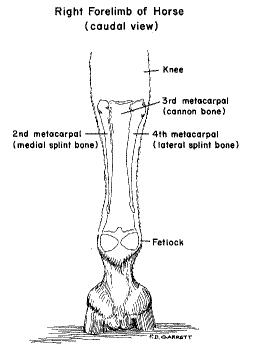| Home Medical Index | First Posted: Nov 4, 2009 Jan 21, 2020 | |
Horse Splints  Splint bones are located on either side of the cannon bone. The interosseus ligament is located between the splint bones and the cannon bone. An injury to the interosseous ligament or the periosteum (The periosteum is the soft tissue covering bone) of the splint bones can cause splints. You hear the term splints in the horse's leg often. So, just what does that mean? "The horse's splint bone is actually what is left of what was once one of his toes. The bone is still there, it just no longer reaches the ground. It still carries weight passed down to it by the carpus (knee)." Recurring Splints What Is A Splint and What Causes them? A splint is an inflammatory condition. It usually develops on the splint bones or "splints" Young horses between the ages of 2 to 3 years old are most prone to splints. However, they can occur in horses 4 years and up. Usually splints will occur when a horse has been put into work at too young an age or are worked too hard on pavement, hard ground, etc. At the walk the horse generally does not show lameness. It is at the trot and canter or in gaited horses at the faster gaits. Conformation problems such as a narrow base, i.e., feet too close together, toe-out, hooves that are not balanced correctly, too much rich food, and the absence of proper minerals can also be the culprit. "A ligament, located between the cannon bone and the splint bones, is quite elastic in young horses. As the horse ages, the ligament ossifies; that is, the ligament is replaced by bone and the three bones fuse... During ossification, there may be inflammation and pain. Jumping, running and working a horse during this time produces further irritation." Splints in Horses Prevention
Four Types of Splints
Symptoms
Diagnostic Techniques Used
Treatments
Prognosis or Long Term Consequences
"Prognosis is excellent in uncomplicated cases. The horse will be able to return to full work once the inflammation and pain ceases. Although the horse usually recovers quite quickly, horses with "blind splints" may take longer because there may be impingement on the suspensory ligament. The calcification of the splint is usually a permanent blemish, though over a period of many years, the excess calcification may be reabsorbed to some degree, occasionally to the point that the splint is no longer visible." For More Information: Speedy Splint RecoveryEquine Lameness Horse Splints |